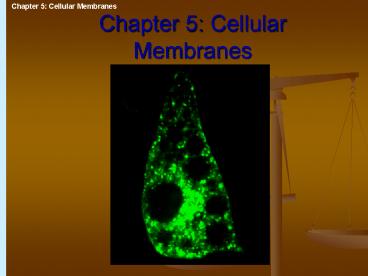Chapter 5: Cellular Membranes PowerPoint PPT Presentation
1 / 23
Title: Chapter 5: Cellular Membranes
1
Chapter 5 Cellular Membranes
2
Membrane Composition and Structure
- Biological membranes consist of lipids, proteins,
and carbohydrates. The fluid mosaic model
describes a phospholipid bilayer in which
membrane proteins move laterally within the
membrane.
3
5.2
figure 05-02.jpg
4
Components
- Phospholipid bilayer
- Transmembrane proteins (integral membrane
proteins) - Interior protein network (peripheral membrane
proteins) - Cell surface markers
5
Membrane Fuctions
- Transport
- Enzyme scaffold
- Cell Surface Receptors
- Identity
- Adhesion and Attachments
6
Cell Recognition, Adhesion and Attachment
- Recognition In an organism or tissue, cells
recognize and bind to each other by means of
membrane proteins protruding from the cell
surface. Glycoproteins and Glycolipids
7
Cell Adhesion and Attachment
- Tight junctions--prevent passage of molecules
through space around cells, create functional
regions, restrict migration of membrane proteins
over the cell surface. - Anchoring Junctionsmechanically attach two
cytoskeletons - Communicating Junctionsdirect connections with
other cells.
8
5.6 Part 1
figure 05-06a.jpg
- Figure 5.6 Part 1
9
Transport
- Passive Substances can diffuse passively across
a membrane by unaided diffusion through the
phospholipid bilayer, facilitated diffusion
through protein channels, or by means of a
carrier protein.
10
Transport
- Diffusion Solutes diffuse across a membrane from
a region with a greater solute concentration to a
region of lesser. Equilibrium is reached when the
concentrations are identical on both sides.
11
Transport
- Osmosis water diffuses from regions of higher
water concentration to regions of lower
concentration.
12
5.8
figure 05-08.jpg
- Figure 5.8
13
5.9
figure 05-09.jpg
Channel proteins and carrier proteins function in
facilitated diffusion
- Figure 5.9
14
5.10
figure 05-10.jpg
- Rate is maxed when the solute concentration
saturates carrier protein
15
Active Transport
- Active transport proteins may be uniports,
symports, or antiports.
16
- In primary active transport, energy from the
hydrolysis of ATP is used to move ions into or
out of cells against their concentration
gradients.
17
- Secondary active transport couples the passive
movement of one solute with its concentration
gradient to the movement of another solute
against its concentration gradient. Energy from
ATP is used indirectly to establish the
concentration gradient resulting in movement of
the first solute.
18
Bulk Transport
- Endocytosis transports macromolecules, large
particles, and small cells into eukaryotic cells
by means of engulfment and by vesicle formation
from the plasma membrane. Phagocytosis,
pinocytosis, receptor-mediated endocytosis. - In exocytosis, materials in vesicles are secreted
from the cell when the vesicles fuse with the
plasma membrane.
19
Cell Signaling
- Receptor proteins have a three-dimensional shape
that fits a specific signal molecule. - When a signal molecule and receptor protein bind,
a change in the receptor protein is induced and a
response in the cell is generated.
20
Intracellular Receptors
- Intracellular receptors are located within the
cell, and trigger a variety of responses,
depending on the receptor. - acting as gene regulators
- acting as enzymes
21
Cell Surface Receptors
- Extracellular signals converted to intracellular
- chemically-gated ion channels
- open or close when signal molecules bind to the
channel - enzyme receptors
- usually activate intracellular proteins by
phosphorylation - G-protein receptors
- activate intermediary protein
22
Cell Surface Receptors
23
Initiating the Intracellular Signal
- Second messengers relay messages from receptors
to target proteins. - cAMP
- calcium

